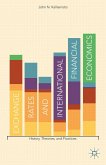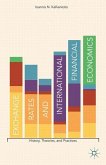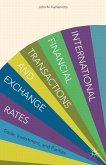Acclaimed for its clarity, Exchange Rates and International Finance provides an approachable guide to the causes and consequences of exchange rate fluctuations, enabling you to grasp the essentials of the theory and its relevance to these major events in currency markets.
The orientation of the book remains towards exchange rate determination, with particular emphasis given to the contributions of modern finance theory.
This sixth edition of this established text addresses the impact of the global financial crisis.
Product Description
Acclaimed for its clarity, Exchange Rates and International Finance provides an approachable guide to the causes and consequences of exchange rate fluctuations, enabling you to grasp the essentials of the theory and its relevance to these major events in currency markets.
The orientation of the book remains towards exchange rate determination, with particular emphasis given to the contributions of modern finance theory.
This sixth edition of this established text addresses the impact of the global financial crisis.
Backcover
Acclaimed for its clarity, Exchange Rates and International Finance provides an approachable guide to the causes and consequences of exchange rate fluctuations, enabling you to grasp the essentials of the theory and its relevance to major events in currency markets.
The sixth edition appears against the background of a world only just recovering from the worst financial collapse in modern history and the ongoing crisis in the Eurozone. Since the last edition, this widely-used textbook has been extensively revised and restructured, with the addition of new material to take account of the most important events of recent years.
NEW TO THE SIXTH EDITION
· A new chapter on heterogeneous information, the exchange rate disconnect puzzle and the scapegoat model
· Extended coverage of risk and the currency carry trade
· New material on the 2008 banking crisis
· Extended coverage of the Eurozone crisis
· Discussion of China – US trade relations
This book is ideal for students of international finance, international macroeconomics or international money as a part of an economics or business programme at advanced undergraduate, MBA or specialist Masters levels.
Laurence Copeland is Emeritus Professor of Finance and Director of the Investment Management Research Unit at Cardiff University, UK.
Preface and acknowledgements
1 Introduction
Introduction
1.1 What is an exchange rate?
1.2 The market for foreign currency
1.3 The balance of payments
1.4 The DIY model
1.5 Exchange rates since World War II: a brief history
1.6 Overview of the book
Summary
Reading guide
Notes
Part 1
THE INTERNATIONAL SETTING
2 Prices in the open economy: purchasing power parity
Introduction
2.1 The law of one price in the domestic economy
2.2 The law of one price in the open economy
2.3 A digression on price indices
2.4 Purchasing power parity
2.5 Purchasing power parity – the facts at a glance
2.6 Purchasing power parity extensions
2.7 Empirical research
2.8 Conclusions
Summary
Reading guide
Notes
3 Financial markets in the open economy
Introduction
3.1 Uncovered interest rate parity
3.2 Covered interest rate parity
3.3 Borrowing and lending
3.4 Covered interest rate parity – the facts
3.5 Efficient markets – a first encounter
3.6 The carry trade paradox
3.7 Purchasing power parity revisited
Summary
Reading guide
Notes
4 Open economy macroeconomics
Introduction
4.1 IS–LM model of aggregate demand
4.2 Aggregate supply
4.3 Conclusions
Summary
Reading guide
Notes
Part 2
EXCHANGE RATE DETERMINATION
5 Flexible prices: the monetary model
Introduction
5.1 The simple monetary model of a floating exchange rate
5.2 The simple monetary model of a fixed exchange rate
5.3 Interest rates in the monetary model
5.4 The monetary model as an explanation of the facts
5.5 Conclusions
Summary
Reading guide
Notes
6 Fixed prices: the Mundell–Fleming model
Introduction
6.1 Setting
6.2 Equilibrium
6.3 Monetary expansion with a floating exchange rate
6.4 Fiscal expansion with a floating exchange rate
6.5 Monetary expansion with a fixed exchange rate
6.6 Fiscal expansion with a fixed exchange rate
6.7 The monetary model and the Mundell–Fleming model compared
6.8 Evidence
6.9 Conclusions
Summary
Reading guide
Notes
7 Sticky prices: the Dornbusch model
Introduction
7.1 Outline of the model
7.2 Monetary expansion
7.3 A formal explanation
7.4 Case study: oil and the UK economy
7.5 Empirical tests: the Frankel model
7.6 Conclusions
Summary
Reading guide
Notes
8 Portfolio balance and the current account
Introduction
8.1 Specification of asset markets
8.2 Short-run equilibrium
8.3 Long-run and current account equilibrium
8.4 Evidence on portfolio balance models
8.5 Conclusions
Summary
Reading guide
Notes
9 Currency substitution
Introduction
9.1 The model
9.2 Evidence on currency substitution
9.3 Conclusions
Summary
Reading guide
Notes
10 General equilibrium models
Introduction
10.1 The Redux model
10.2 Extensions of Redux
10.3 Evidence
10.4 Conclusions
Summary
Reading guide
Notes
Appendix 10.1: Derivation of price index (Equation 10.2)
Appendix 10.2: Derivation of household demand (Equations 10.6 and 10.6′)
Appendix 10.3: Log linearisation of model solution (Equations L1–L4)
Appendix 10.4: Sticky prices
Part 3
A WORLD OF UNCERTAINTY
11 Market efficiency and rational expectations
Introduction
11.1 Mathematical expected value
11.2 Rational expectations
11.3 Market efficiency
11.4 Unbiasedness
11.5 The random walk model
11.6 Testing for efficiency: some basic problems
11.7 Spot and forward rates: background facts
11.8 Results
11.9 Conclusions
Summary
Reading guide
Notes
12 The ‘news’ model, exchange rate volatility and forecasting
Introduction
12.1 The ‘news’ model: a simple example
12.2 The monetary model revisited
12.3 Testing the ‘news’
12.4 Results
12.5 Volatility tests, bubbles and the peso problem
12.6 Conclusions
Summary
Reading guide
Notes
13 The risk premium
Introduction
13.1 Assumptions
13.2 A simple model of the risk premium: mean–variance analysis
13.3 A general model of the risk premium
13.4 The evidence on the risk premium
13.5 Conclusions
Summary
Reading guide
Notes
Part 4
FIXED EXCHANGE RATES
14 Target zones
Introduction
14.1 What is a target zone
14.2 Effect of target zones
14.3 Smooth pasting
14.4 An option interpretation
14.5 A honey moon for policymakers?
14.6 Beauty and the beast: the target zone model meets the facts
14.7 Intramarginal interventions: leaning against the wind
14.8 Credibility
§Acclaimed for its clarity, Exchange Rates and International Finance provides an approachable guide to the causes and consequences of exchange rate fluctuations, enabling you to grasp the essentials of the theory and its relevance to these major events in currency markets.§§ §§The orientation of the book remains towards exchange rate determination, with particular emphasis given to the contributions of modern finance theory. §§ §§This sixth edition of this established text addresses the impact of the global financial crisis. §
Hinweis: Dieser Artikel kann nur an eine deutsche Lieferadresse ausgeliefert werden.
The orientation of the book remains towards exchange rate determination, with particular emphasis given to the contributions of modern finance theory.
This sixth edition of this established text addresses the impact of the global financial crisis.
Product Description
Acclaimed for its clarity, Exchange Rates and International Finance provides an approachable guide to the causes and consequences of exchange rate fluctuations, enabling you to grasp the essentials of the theory and its relevance to these major events in currency markets.
The orientation of the book remains towards exchange rate determination, with particular emphasis given to the contributions of modern finance theory.
This sixth edition of this established text addresses the impact of the global financial crisis.
Backcover
Acclaimed for its clarity, Exchange Rates and International Finance provides an approachable guide to the causes and consequences of exchange rate fluctuations, enabling you to grasp the essentials of the theory and its relevance to major events in currency markets.
The sixth edition appears against the background of a world only just recovering from the worst financial collapse in modern history and the ongoing crisis in the Eurozone. Since the last edition, this widely-used textbook has been extensively revised and restructured, with the addition of new material to take account of the most important events of recent years.
NEW TO THE SIXTH EDITION
· A new chapter on heterogeneous information, the exchange rate disconnect puzzle and the scapegoat model
· Extended coverage of risk and the currency carry trade
· New material on the 2008 banking crisis
· Extended coverage of the Eurozone crisis
· Discussion of China – US trade relations
This book is ideal for students of international finance, international macroeconomics or international money as a part of an economics or business programme at advanced undergraduate, MBA or specialist Masters levels.
Laurence Copeland is Emeritus Professor of Finance and Director of the Investment Management Research Unit at Cardiff University, UK.
Preface and acknowledgements
1 Introduction
Introduction
1.1 What is an exchange rate?
1.2 The market for foreign currency
1.3 The balance of payments
1.4 The DIY model
1.5 Exchange rates since World War II: a brief history
1.6 Overview of the book
Summary
Reading guide
Notes
Part 1
THE INTERNATIONAL SETTING
2 Prices in the open economy: purchasing power parity
Introduction
2.1 The law of one price in the domestic economy
2.2 The law of one price in the open economy
2.3 A digression on price indices
2.4 Purchasing power parity
2.5 Purchasing power parity – the facts at a glance
2.6 Purchasing power parity extensions
2.7 Empirical research
2.8 Conclusions
Summary
Reading guide
Notes
3 Financial markets in the open economy
Introduction
3.1 Uncovered interest rate parity
3.2 Covered interest rate parity
3.3 Borrowing and lending
3.4 Covered interest rate parity – the facts
3.5 Efficient markets – a first encounter
3.6 The carry trade paradox
3.7 Purchasing power parity revisited
Summary
Reading guide
Notes
4 Open economy macroeconomics
Introduction
4.1 IS–LM model of aggregate demand
4.2 Aggregate supply
4.3 Conclusions
Summary
Reading guide
Notes
Part 2
EXCHANGE RATE DETERMINATION
5 Flexible prices: the monetary model
Introduction
5.1 The simple monetary model of a floating exchange rate
5.2 The simple monetary model of a fixed exchange rate
5.3 Interest rates in the monetary model
5.4 The monetary model as an explanation of the facts
5.5 Conclusions
Summary
Reading guide
Notes
6 Fixed prices: the Mundell–Fleming model
Introduction
6.1 Setting
6.2 Equilibrium
6.3 Monetary expansion with a floating exchange rate
6.4 Fiscal expansion with a floating exchange rate
6.5 Monetary expansion with a fixed exchange rate
6.6 Fiscal expansion with a fixed exchange rate
6.7 The monetary model and the Mundell–Fleming model compared
6.8 Evidence
6.9 Conclusions
Summary
Reading guide
Notes
7 Sticky prices: the Dornbusch model
Introduction
7.1 Outline of the model
7.2 Monetary expansion
7.3 A formal explanation
7.4 Case study: oil and the UK economy
7.5 Empirical tests: the Frankel model
7.6 Conclusions
Summary
Reading guide
Notes
8 Portfolio balance and the current account
Introduction
8.1 Specification of asset markets
8.2 Short-run equilibrium
8.3 Long-run and current account equilibrium
8.4 Evidence on portfolio balance models
8.5 Conclusions
Summary
Reading guide
Notes
9 Currency substitution
Introduction
9.1 The model
9.2 Evidence on currency substitution
9.3 Conclusions
Summary
Reading guide
Notes
10 General equilibrium models
Introduction
10.1 The Redux model
10.2 Extensions of Redux
10.3 Evidence
10.4 Conclusions
Summary
Reading guide
Notes
Appendix 10.1: Derivation of price index (Equation 10.2)
Appendix 10.2: Derivation of household demand (Equations 10.6 and 10.6′)
Appendix 10.3: Log linearisation of model solution (Equations L1–L4)
Appendix 10.4: Sticky prices
Part 3
A WORLD OF UNCERTAINTY
11 Market efficiency and rational expectations
Introduction
11.1 Mathematical expected value
11.2 Rational expectations
11.3 Market efficiency
11.4 Unbiasedness
11.5 The random walk model
11.6 Testing for efficiency: some basic problems
11.7 Spot and forward rates: background facts
11.8 Results
11.9 Conclusions
Summary
Reading guide
Notes
12 The ‘news’ model, exchange rate volatility and forecasting
Introduction
12.1 The ‘news’ model: a simple example
12.2 The monetary model revisited
12.3 Testing the ‘news’
12.4 Results
12.5 Volatility tests, bubbles and the peso problem
12.6 Conclusions
Summary
Reading guide
Notes
13 The risk premium
Introduction
13.1 Assumptions
13.2 A simple model of the risk premium: mean–variance analysis
13.3 A general model of the risk premium
13.4 The evidence on the risk premium
13.5 Conclusions
Summary
Reading guide
Notes
Part 4
FIXED EXCHANGE RATES
14 Target zones
Introduction
14.1 What is a target zone
14.2 Effect of target zones
14.3 Smooth pasting
14.4 An option interpretation
14.5 A honey moon for policymakers?
14.6 Beauty and the beast: the target zone model meets the facts
14.7 Intramarginal interventions: leaning against the wind
14.8 Credibility
§Acclaimed for its clarity, Exchange Rates and International Finance provides an approachable guide to the causes and consequences of exchange rate fluctuations, enabling you to grasp the essentials of the theory and its relevance to these major events in currency markets.§§ §§The orientation of the book remains towards exchange rate determination, with particular emphasis given to the contributions of modern finance theory. §§ §§This sixth edition of this established text addresses the impact of the global financial crisis. §
Hinweis: Dieser Artikel kann nur an eine deutsche Lieferadresse ausgeliefert werden.








